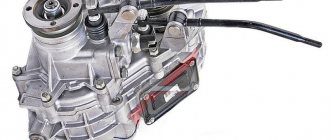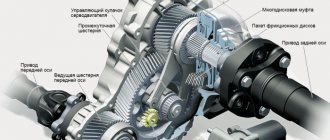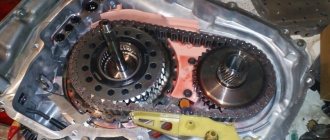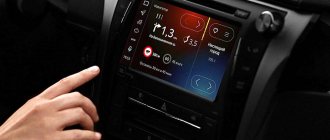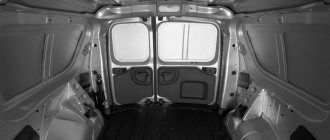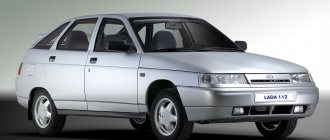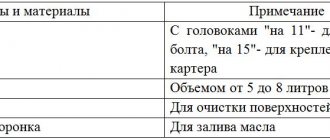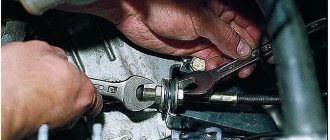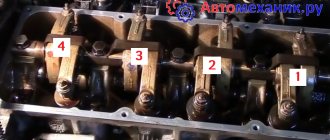A car's transmission is a whole complex of mechanisms that ensures the functioning of all its driving mechanisms and transfers the energy of the internal combustion engine to them. Literally, the word “transmission” from English into Russian can be translated as follows: “transfer”, “transfer”, “translation”. In fact, even a simple chain drive on a bicycle is already a transmission. But when applied to bicycles, the word “transmission” did not catch on. It is customary to say “transfer”. But in the field of mechanical engineering and transport technologies, the concept of “transmission” is applied both to the mechanisms connecting the internal combustion engine with moving elements, and to the systems that ensure the functioning of such mechanisms. Although, if we are already talking about a bicycle, then using its example it is easiest to clearly explain the essence of the transmission as such. To move quickly on a bicycle, you need a high rotation speed of the rear drive wheel. A chain drive ideally allows you to solve this problem without changing the diameter of the wheel. True, if we consider the structure of cars, then the engine already appears, and the design becomes more complicated, as does the range of its “responsibilities”. For example, when driving an internal combustion engine, you constantly need to expend energy to overcome all kinds of resistance, including overcoming the inertia of the car itself. Fuel consumption, safety and comfort of the driver and passengers of the vehicle, and the efficiency of performing certain tasks depend on the quality of transmission mechanisms (MT). For example, MT forklifts provide the operator with comfortable interaction with the forklift, freely drive up to the racks and carefully unload it. The smoothness of the transfer of actions from the internal combustion engine to the mechanisms of the reaping part depends on the MT of the combine. The MT of a mining dump truck determines whether it can provide an effective start after the body is fully loaded or whether it can move uphill at high speed.
Purpose of a car transmission
The purpose of this mechanism is simple - to transmit the torque coming from the motor to the drive wheels and change the rotation speed of the secondary shafts. When the engine starts, the flywheel rotates in accordance with the crankshaft speed. If it had a rigid grip on the drive wheels, then it would be impossible for the car to start moving smoothly, and every stop of the vehicle would require the driver to turn off the engine.
Everyone knows that battery power is used to start the engine. Without a transmission, the car would immediately start moving using this energy, which would drain the power supply very quickly.
The transmission is designed so that the driver has the opportunity to disconnect the driving wheels of the car from the engine in order to:
- Start the engine without overcharging the battery;
- Accelerate the vehicle without increasing engine speed to a critical value;
- Use coasting motion, for example, in case of towing;
- Choose a mode that would not harm the engine and ensure safe traffic movement;
- Stop the car without having to turn off the engine (for example, at a traffic light or to let pedestrians cross a zebra crossing).
Also, the car's transmission allows you to change the direction of torque. This is required for reversing.
And another feature of the transmission is to convert the engine crankshaft speed into an acceptable wheel speed. If they were spinning at speeds in the range of 7 thousand, then either their diameter would have to be very small, or all the cars would be sports cars, and they could not be safely driven in crowded cities.
The transmission evenly distributes the released engine power so that the moment of transformation makes possible a soft and smooth start and uphill movement, but at the same time allows the use of internal combustion engine power to accelerate the vehicle.
Device
During the combustion of fuel in the power unit, a large amount of free energy is generated, which must be transferred to the driving wheels of the vehicle. The simplest transmission consists of four parts: clutch, gearbox, drive axle and differential. The first element is located between the motor and gearbox. The clutch ensures smooth operation when starting or changing gears. There are two versions of the mechanism - dry and wet. In the first case, the discs operate using friction, in the second they operate in a liquid. A number of cars have a hydraulic or electromagnetic clutch, but such variations are not very common. The mechanism itself is based on two disks, one of which is the master and the second is the slave. In the normal state they are compressed, but when the corresponding pedal is pressed they are released.
The gearbox controls wheel speed, reverse driving, and disconnects the engine and transmission for long periods of time. The gearbox can be stepped or continuously variable. The first includes “mechanics” and a robot, the second – a variator. The most reliable gearbox is considered to be a manual one, but operating it requires appropriate skills. So far, manual transmission is the most common, but it is gradually being replaced by automatic transmission.
A bridge is a support on which the frame of a vehicle is attached. He can be a leader or a follower. The first receives torque from the box and sets the wheels in motion. The driven axle acts as a simple support. It can also be front and rear, and trucks also have a middle one.
A differential is a structure that divides the mechanical energy of the power unit into two streams and directs it to the wheels. This element prevents tires from slipping on uneven road surfaces. The differential is indispensable when traveling in icy conditions, in winter or on poor roads.
Transmission types
Although manufacturers have developed and continue to create different versions of transmissions, they can all be divided into four types. Below is a brief description of the operating features of each of them.
Manual Transmission
This is the very first and most popular type of transmission. Even many modern motorists choose this particular gearbox. The reason for this is a simpler structure, the ability to use the chassis of the car instead of a starter to start the engine if the battery is low (read about how to do this correctly here ).
The peculiarity of this box is that the driver himself determines when and what speed to turn on. Of course, this requires a good understanding of what speed to upshift or downshift at.
Due to its reliability and relative ease of maintenance and repair, this type of transmission remains a leader in the gearbox rating. For the production of mechanics, the manufacturer does not spend as much money and resources as for the production of automatic machines or robots.
Gear shifting occurs as follows. The gearbox device includes a clutch disc, which, when you press the appropriate pedal, disconnects the engine flywheel from the drive mechanism of the box. While the clutch is disengaged, the driver shifts the unit to another gear. This way the car accelerates (or slows down), and the engine does not suffer.
The design of manual transmissions includes a set of gears and shafts that are interconnected in such a way that the driver can quickly change the desired gear. To reduce noise, the mechanism uses gears with oblique teeth. And for stability and speed of engagement of elements, modern manual transmissions use synchronizers. They synchronize the rotation speed of the two shafts.
Read about the mechanics in a separate article.
Robotic transmission
In terms of design and principle of operation, robots are very similar to their mechanical counterparts. Only in them the selection and shifting of gears is carried out by the car's electronics. Most robotic transmissions have a manual mode option, where the driver uses the shift lever located on the mode selector. Some car models have steering wheel paddle shifters instead of this lever, with which the driver upshifts or downshifts.
To increase stability and reliability of operation, modern robots are equipped with a dual clutch system. This modification is called selective. Its peculiarity is that one clutch disc ensures normal operation of the box, and the second, before shifting the next gear, prepares the mechanisms for activating speed.
Read about other features of the robotic gear shift system here.
Automatic transmission
Such a box is in second place in the ranking of similar mechanisms after mechanics. Such a transmission has the most complex structure. It has many additional elements, including sensors. However, unlike its robotic and mechanical counterparts, the automatic does not have a clutch disc. Instead, a torque converter is used.
A torque converter is a mechanism that operates based on the movement of oil. The working fluid is supplied by a pump to the clutch impeller, which drives the transmission drive shaft. A distinctive feature of this box is the absence of a rigid coupling between the transmission mechanism and the engine flywheel.
An automatic transmission works on a similar principle to a robot. The electronics itself determines the moment of transition to the desired mode. In addition, many automatic machines are equipped with a semi-automatic mode, when the driver, using the shift lever, commands the system to switch to the desired gear.
Earlier modifications were equipped only with a torque converter, but today there are also electronic modifications. In the second case, the electronic control can switch to several modes, each of which has its own speed switching system.
The design and operating system of the machine was described in more detail in an earlier review.
Continuously variable transmission
This type of transmission is also called a CVT. The only gearbox that does not have stepped gear shifting. Torque distribution is controlled by moving the walls of the drive shaft pulley.
The drive and driven shafts are connected using a belt or chain. The choice of gear ratio is determined by the transmission electronics based on information received from sensors in various vehicle systems.
Here is a small table of the pros and cons of each type of box:
| Box type: | Advantages: | Flaws: |
| Manual transmission (mechanics) | High efficiency; Saves fuel; Simple device; Inexpensive to repair; High reliability. | A beginner needs to practice a lot to effectively use the potential of the box; Compared to other gearboxes, this one does not provide as much comfort. |
| "Robot" | Comfort when shifting (there is no need to reach for the lever every time you need to shift); Electronics will determine the most optimal moment to switch to the desired gear (this will be especially useful for those who find it difficult to get used to this parameter). | There is a delay when changing speed; Changing to an up/down gear is often accompanied by jerks; Does not allow the driver to save fuel. |
| Automatic | Comfortable gear shifting (smooth and almost imperceptible); When you press the gas pedal sharply, it shifts to a lower gear in order to accelerate the car as quickly as possible (for example, when overtaking). | Expensive maintenance and repairs; Does not save fuel; Not economical in terms of oil consumption; Difficult to repair, which is why you need to look for expensive service; not every mechanic is able to correctly set up or repair the mechanism; It is impossible to start the engine from a tug. |
| Variable speed drive | The smoothest shifting of gear ratios without raising the engine speed (which prevents it from overheating); Increased driving comfort; Careful use of the engine resource; Ease of driving. | Expensive maintenance; Sluggish acceleration (compared to previous analogues); Does not allow using the engine in economical mode in terms of fuel consumption; It is impossible to start the engine from a tug. |
For more information about the differences between these types of boxes, watch this video:
What is the difference between a manual transmission, an automatic transmission, a variator and a robotic one?
Automatic transmission device
Automatic transmission provides automatic gear shifting. This means that the person driving the car does not need to depress the clutch and shift the gearshift lever. The automatic transmission was developed at the beginning of the 20th century; the basic principles of its operation have been preserved since that time.
The classic version of an automatic transmission is a torque converter gearbox, consisting of the following components:
- torque converter;
- planetary mechanism.
The latter includes the following details
- hydraulic or electronic automatic transmission control unit;
- friction clutch;
- overrunning clutch;
- band brake;
- oil pump.
The torque converter ensures the transmission of torque from the power unit and essentially replaces the clutch. Torque transmission is carried out due to the accumulation and use of kinetic energy of the fluid located inside the torque converter housing. It also provides damping of shocks that occur when changing gears due to the absence of a rigid kinematic connection between its elements.
The planetary mechanism provides speed selection and transmission of torque from the torque converter to the wheel drives. In a planetary mechanism, some gears are locked and others are unlocked, which determines the choice of gear ratio. The box is controlled by a hydraulic or electronic control unit, which collects information from various sensors and determines the required operating mode.
A classic automated transmission has many advantages: it ensures comfortable driving, has a long service life, often superior to a manual transmission, and prevents common driver errors when shifting gears. Of course, there are also disadvantages: the automatic machine is quite expensive, so economy class cars are rarely equipped with it. Also, a transmission of this type increases the weight of the car, reduces dynamics and maximum speed, increases fuel consumption and requires careful maintenance. In the event of a breakdown, repairing an automatic transmission will cost the car owner a considerable amount.
Mechanical transmission
The peculiarity of a manual transmission is that the entire process of transition between gears occurs solely due to the mechanical intervention of the driver. Only he squeezes the clutch, interrupting the transmission of torque from the flywheel to the clutch disc. It is solely due to the actions of the driver that gears are changed and the supply of torque to the gearbox gears is resumed.
But the concept of a manual transmission should not be confused with a manual transmission. The box is a unit with the help of which traction forces are distributed. In a manual transmission, torque is transmitted through a mechanical transmission. That is, all elements of the system are directly connected to each other.
There are several advantages of mechanical transmission of torque (mainly due to a gear connection):
- Maximum efficiency, since there is no loss of power due to the operation of associated mechanisms, as, for example, in a torque converter;
- The cost of a manual transmission is the lowest among identical analogues with a different type of torque transmission due to a simpler design;
- The same simple design allows manufacturers to create units with small dimensions.
Definition of “transmission”
According to scientific publications of mechanical engineering, a transmission is a set of mechanisms and assembly units that connect the engine with the drive wheels, in this case, of a vehicle, as well as a set of systems that ensures the operation of the transmission.
The transmission is a set of units and components that transmit torque from the motor to the drive wheels, and traction forces, speed and direction of movement can change. A car transmission includes mechanisms that in science are classified as part of the power unit - this is the gearbox and clutch.
Hydromechanical transmission
The device of such a unit includes:
- Hydrodynamic converter;
- Mechanical gearbox.
The advantages of such a transmission are that it makes it easier to control gear shifts thanks to the automated transition between gears. This box also provides additional damping of torsional vibrations. Thanks to this, the load on the unit parts at maximum loads is reduced.
The disadvantages of a hydromechanical transmission include low efficiency due to the operation of the torque converter. Since the unit uses a hydraulic unit with a torque converter, it requires more oil. It requires an additional cooling system. Because of this, the box has increased dimensions and more weight compared to similar mechanics or a robot.
Hydraulic transmission
The peculiarity of such a box is that gear shifting is performed using hydraulic units. A torque converter or a fluid coupling can be installed in the design of the unit. This mechanism connects the required pair of shafts and gears.
The advantage of a hydraulic transmission is the smooth switching of speeds. Torque is transmitted as smoothly as possible, and torsional vibrations in such a box are minimized due to the effective damping of these forces.
The disadvantages of this gearbox include the need to use individual fluid couplings for all gears. Due to its large size and weight, hydraulic transmissions are used in railway transport.
Hydrostatic transmission
This box is based on axial plunger hydraulic units. The advantages of the transmission are its small size and weight. Also, in this design there is no mechanical connection between the links, due to which they can be spread over long distances. Thanks to this, the gearbox has a large gear ratio.
The disadvantages of a hydrostatic transmission are that it is demanding on the quality of the working fluid. It is also sensitive to pressure in the hydraulic line, which ensures gear shifting. Due to the characteristics of the gearbox, it is used mainly in road construction equipment.
Electromechanical transmission
The design of the electromechanical box uses at least one traction motor. An electric generator is installed in it, as well as a controller that controls the generation of energy necessary for the operation of the gearbox.
By using an electric motor(s), the traction force is controlled. Torque is transmitted over a wider range, and there is no rigid coupling between mechanical components.
The disadvantages of such a transmission are its large size (a powerful generator and one or more electric motors are used), and at the same time its weight. If we compare such boxes with a mechanical analogue, they have significantly lower efficiency.
Front-wheel drive transmission
The design of the front-wheel drive transmission consists of:
- Clutches (if it is mechanical or robotic);
- Gearboxes;
- Main gear;
- Differential;
- Shafts that drive the front wheels.
All elements of such a transmission are enclosed in one block located across the engine compartment. The combination of gearbox and engine is sometimes called a model with a transverse engine. This means that the car has front-wheel drive or all-wheel drive.
Rear-wheel drive transmission
The rear-wheel drive transmission design consists of:
- Clutches (if it is mechanical or robotic);
- Gearboxes;
- Main gear;
- Differential;
- Cardan transmission;
- Half shafts.
Most classic cars were equipped with just such a transmission. As for the implementation of torque transmission, the rear-wheel drive transmission is as simple as possible for this task. The driveshaft connects the rear axle to the gearbox. To reduce vibrations, supports are used that are slightly softer than those installed in front-wheel drive vehicles.
All-wheel drive transmission
separately for details on what all-wheel drive is and how torque transmission is implemented in it ). The reason is that the unit must simultaneously distribute torque to all wheels. There are three types of such transmission:
- Permanent all-wheel drive. In this version, the unit is equipped with an interaxle differential, which distributes torque to both axles and, depending on the quality of adhesion of the wheels to the road surface, changes the forces between them.
- Manual connection of all-wheel drive. In this case, the design is equipped with a transfer case (read more about this mechanism in another article ). The driver independently determines at what point the second axle needs to be engaged. By default, the car can be either front- or rear-wheel drive. Instead of a center differential, cross-axle differentials are usually used.
- Automatically connected all-wheel drive. In such modifications, instead of a center differential, a viscous coupling or an analogue of a friction type is installed. An example of how such a clutch works is discussed here .
Mechanism operation
All motorists know that the gearbox has several speeds: low, high, and additional intermediate ones. If the driver selects the lowest setting, the vehicle's transmission will have little effect on the engine. The car will move slowly, and this will increase its acceleration at the moments when you need to get underway and continue moving.
When the gearbox is set to high settings, the rotational force will be reduced and the speed will increase. At the same time, the transmission allows you to determine the optimal operating mode of the power unit for maximum optimization of fuel consumption. As the speed of the machine increases, its power will decrease. To overcome obstacles on the way, it is recommended to reduce the speed of the vehicle. You should also remember that when driving fast, it is not advisable to transport heavy loads, since in such cases the vehicle will not have enough power.
Modern cars with manual transmission most often have several intermediate speeds. This allows drivers to easily cope with various obstacles while driving.
Vehicle transmission units
Regardless of the type of transmission, this mechanism consists of several components that ensure efficiency and high efficiency of the device. These are the units the gearbox consists of.
Clutch disc
This element provides rigid coupling of the engine flywheel with the main drive drive shaft. However, if necessary, this mechanism also disconnects the motor and gearbox. The manual transmission is equipped with a clutch basket, and the robot has a similar device.
In automatic versions, this function is performed by a torque converter. The only difference is that the clutch disc can provide a strong connection between the engine and the transmission mechanism even when the engine is turned off. This allows the transmission to be used as a recoil mechanism in addition to the weak handbrake. The clutch allows you to start the engine from a pusher, which cannot be done with an automatic machine.
The clutch mechanism consists of the following elements:
- Friction discs;
- Basket (or housing in which all the elements of the mechanism are located);
- Fork (moves the pressure plate when the driver presses the clutch pedal);
- Drive or input shaft.
Among the types of clutch are:
- Dry. In such modifications, friction force is used, due to which the friction surfaces of the disks do not allow them to slip during the transmission of torque;
- Wet. A more expensive modification that uses torque converter oil, which extends the service life of the mechanism and also makes it more reliable.
main gear
The main task of the main gear is to receive the forces coming from the motor and transmit them to the connected units, namely the drive axle. The main gear increases torque (torque) and at the same time reduces the speed of the driving wheels of the car.
Front-wheel drive vehicles are equipped with this mechanism near the gearbox differential. Rear-wheel drive models have this mechanism in the rear axle housing. The GP device includes an axle shaft, drive and driven gears, semi-axial gears, and satellite gears.
Differential
Transmits torque, changes it and distributes it to misaligned mechanisms. The shape and operating principle of the differential differ depending on the drive of the machine:
- Rear-wheel drive model. The differential is installed in the axle housing;
- Front wheel drive model. The mechanism is installed in the gearbox;
- All-wheel drive model. The differential is located in the transfer case.
The differential design includes a planetary gearbox. There are three modifications of the planetary gear:
- Conical – used in cross-axle differential;
- Cylindrical – used in the interaxle differential of an all-wheel drive car;
- Worm - considered a universal modification that can be used in both inter-wheel and inter-axle differentials.
The differential device includes axial gears fixed in the housing. They are connected to each other by a planetary gear, which consists of satellite gears. Read more about the design of the differential and the principle of operation here .
Cardan transmission
A cardan transmission is a shaft consisting of two or more parts that are connected to each other using a hinge mechanism. It is used in different parts of the car. The main application is in rear-wheel drive vehicles. The gearbox in such cars is often located lower than the rear axle gearbox. So that neither the gearbox mechanism nor the gearbox experiences additional load, the shaft located between them must be divided into sections, the connection of which would ensure smooth rotation when the unit is deformed.
If the cardan is faulty, then strong noise and vibration are felt during the transmission of torque. When the driver notices this effect, he should pay attention to repairs so that the transmission mechanisms do not fail due to increased vibrations.
In order for the transmission to serve as efficiently as possible and for a long time without repairs, each box must be serviced. The manufacturer sets its own scheduled maintenance period, which the car owner is informed about in the technical documentation. Most often, this period is around 60 thousand kilometers of the car. Maintenance includes changing the oil and filter, as well as resetting errors, if any, in the electronic control unit.
More details about caring for the box are described in another article.
Transmission
This is the most difficult part of any transmission, even a manual one. Thanks to this unit, traction forces are evenly distributed. This occurs either through the direct participation of the driver (manual transmission), or through the operation of electronics, as in the case of an automatic or robotic transmission.
Regardless of the type of gearbox, this unit allows you to make the most efficient use of engine power and torque in different operating modes. The gearbox allows the car to move faster with minimal changes in engine speed (for this, the driver or electronics need to determine the appropriate speed) or to subject the engine to less load when driving uphill.
Also, thanks to the gearbox, the direction of rotation of the driven shaft changes. This is necessary to move the car in reverse. This unit allows you to transfer all the torque from the engine to the drive wheels. The gearbox allows you to completely disconnect the motor from the drive wheels. This is necessary when the car must come to a complete stop, but the motor must continue to run. For example, a car should be in this mode when stopping at a traffic light.
Among the gearboxes there are the following varieties:
- Mechanical. This is the simplest type of box in which the distribution of traction forces is carried out directly by the driver. All other types of boxes can easily be classified as automatic types.
- Automatic. This box is based on a torque converter, and the gear ratios change automatically.
- Robot. This is an automatic analogue of a manual transmission. A special feature of the robotic gearbox is the presence of a double clutch, which ensures the fastest gear shifting.
- Variable speed drive. This is also an automatic transmission. Only traction forces are distributed by changing the diameter of the belt or drive chain.
Thanks to the presence of a gearbox, you can use the same engine speed, but change the speed of rotation of the wheels. This, for example, comes in handy when the car overcomes off-road conditions.
Main bridge
A transmission axle refers to a supporting part that is attached to the car frame, and inside it is a mechanism for transmitting torque to the wheels. In passenger vehicles, axles are used in rear-wheel drive or all-wheel drive models. To transfer torque from the gearbox to the axle, a cardan drive is used. The features of this element are described in another article .
A car may have a driving and driven axle. A gearbox is installed in the drive axle, which converts the transverse rotation of the shaft (direction across the car body) into longitudinal rotation (direction along the body) of the drive wheels. Trucks may have more than one drive axle.
Transfer case
The transfer case is used only in all-wheel drive transmissions (torque is transmitted to all wheels). It, like the main gearbox, has a set of gears that allow you to change gear ratios (multiplier) to different pairs of wheels to increase torque. This is necessary in all-terrain vehicles or heavy-duty tractors.
Constant-velocity joint
This transmission element is used in cars in which the front wheels are driven. This joint is directly connected to the drive wheels and is the last link in the transmission.
The presence of this mechanism is due to the fact that when the front wheels turn, they should receive the same amount of torque. This mechanism operates on the principle of a cardan transmission. In a car, two CV joints are used on one wheel - internal and external. They provide constant communication with the differential.
Purpose and transmission diagrams
Purpose. The vehicle's transmission serves to transmit torque from the engine to the drive wheels. In this case, the transmitted torque changes in magnitude and is distributed in a certain ratio between the drive wheels.
The torque on the drive wheels of a car depends on the transmission gear ratio, which is equal to the ratio of the angular speed of the engine crankshaft to the angular speed of the drive wheels. The transmission gear ratio is selected depending on the purpose of the vehicle, its engine parameters and the required dynamic qualities.
The transmission includes:
- clutch,
- Transmission,
- cardan transmission,
- main gear installed in the drive axle housing,
- differential
- axle shafts
The clutch allows you to briefly disconnect the transmission from the engine and ensures smooth engagement of the transmission when the vehicle is moving away or when changing gears.
The gearbox is used to obtain different traction forces on the drive wheels by changing the torque transmitted from the engine to the driveshaft, as well as to change the direction of rotation of the drive wheels when reversing and to disconnect the transmission from the engine for a long time.
The cardan transmission allows you to transmit torque from the output shaft of the gearbox to the rear axle at a changing (as the car moves) angle between the axes of the gearbox shaft and the drive shaft of the main gear.
The main gear serves to transmit torque at an angle of 90 degrees from the driveshaft to the axle shafts, as well as to reduce the number of revolutions of the drive wheels in relation to the number of revolutions of the driveshaft. Reducing the rotation speed of the transmission mechanisms after the main gear leads to an increase in torque and, accordingly, increases the traction force on the wheels.
The differential allows the right and left drive wheels to rotate at different speeds when cornering and on rough roads. Two axle shafts connected to the differential through side gears transmit torque from the differential to the right and left drive wheels. Differentials installed between the wheel drives of the drive axle are called inter-wheel differentials, and between different axles - inter-axle differentials (in all-wheel drive transmissions).
Based on the method of transmitting torque, transmissions are divided into mechanical, hydraulic, electrical and combined (hydromechanical, electromechanical). On domestic cars, the most common are mechanical transmissions, in which the transmission mechanisms consist of rigid, non-deformable elements (metal shafts and gears). On buses from the Likinsky and Lvov plants, as well as on heavy-duty BelAZ vehicles, hydromechanical transmissions with automated gear shifting are used. Some heavy-duty BelAZ vehicles have an electromechanical transmission with motor wheels.
Car transmission diagram. It is determined by its general layout: engine placement, number and location of drive axles, type of transmission.
Transmission diagrams: a - 4X2 car, b - front-wheel drive 4X2 car, c - 4X4 car, d - 6X4 car
Cars with a manual transmission and a 4X2 wheel arrangement most often have a front engine, rear drive wheels and a central location of transmission units (cars ZIL-130, MAZ-5335, GAZ-24, etc.). Here, engine 1, clutch 2 and gearbox 3 (Fig. a) are combined into one unit and form a power unit. Torque from gearbox 3 is transmitted by cardan transmission 4 to the driving rear axle 5.
The transmission of the front-wheel drive VAZ-2108 with a 4X2 wheel arrangement has significant differences (Fig. 6). A special feature of this scheme is that the front axle is driven by steered wheels. This required combining engine 1, clutch 2, gearbox 3, drive axle mechanisms 5 (main gear and differential), universal joints 6 of equal angular speeds connected to the front steered wheels into a single power unit.
(Fig. c) shows a diagram of the transmission of a car with front and rear drive axles (UAZ-469 car). A distinctive feature of this scheme is the use of a transfer case 7 in the transmission, which transmits torque to the front 8 and rear 5 drive axles through intermediate 9 cardan shafts. The transfer case has a device for turning the front axle on and off and an additional reduction gear, which allows you to significantly increase the torque on the wheels of the car in necessary cases.
The mechanical transmission diagram of three-axle KamAZ trucks is shown in (Fig. d). On these cars, the middle 10 and rear 5 axles are driving. Torque is transmitted to them by one driveshaft 4, and the main gear of the middle axle has a center differential and a drive shaft that transmits torque to the driveshaft 11 of the rear axle drive. In other transmission schemes for three-axle vehicles, torque can be transmitted to the drive axles separately by driveshafts from the transfer case (Ural-375 vehicle).
Schemes of hydromechanical transmissions provide for the combination of an engine and a hydromechanical gearbox in a single block, the torque from which is transmitted to the drive wheels through the driveshaft and rear axle mechanisms, as in a conventional mechanical transmission.
On vehicles (BelAZ) with an electromechanical transmission, the diesel engine drives a DC generator, the energy from which is transmitted through wires to the electric motors of the wheels. The wheel electric motor is mounted in the wheel rim together with a reduction mechanical gearbox. This design is called an electric motor-wheel.
Features of popular transmissions 4Matic, xDrive, 4Motion, Quattro
- 4Matic all-wheel drive systems (installed on numerous Mercedes-Benz passenger models) with permanent all-wheel drive include freewheel and center differentials that allow the engine torque to be divided into two axles. Each axle, thanks to free differentials, can rotate freely at different speeds. In addition, the 4Matic provides driving control through a stability control system (traction control, anti-lock brakes and traction control are provided).
- xDrive all-wheel drive transmissions (developed by BMW) are distinguished by the presence of a friction multi-plate clutch. It acts as a differential. Also, one of the main features of the solution is that the system provides the ability to redistribute the interaxle torque in the widest possible range (0 to 100%).
- Quattro system (Audi). A distinctive feature is that the MT and ICE are located longitudinally. Most Quattro transmissions have an electronically locking differential. Thanks to it, the problem of slipping of the drive wheels when accelerating on a slippery road surface automatically disappears.
- 4 Motion (popular MT Volkswagen). The peculiarity of the scheme is that the torque of the internal combustion engine is distributed among the axes depending on the situation on the road.
Most Quattro and 4Motion transmissions have an electronically locking differential. Thanks to it, the problem of slipping of the drive wheels when accelerating on a slippery road surface automatically disappears.
Principle of operation
The car's transmission operates in the following sequence:
- The engine starts thanks to the coordinated operation of the ignition and fuel supply systems.
- During the alternate combustion of the air-fuel mixture in the engine cylinders, the crankshaft rotates.
- Torque is transmitted from the crankshaft through the flywheel, to which the clutch basket is connected, to the drive shaft of the gearbox.
- Depending on the type of gearbox, the torque is distributed either through the connected gears or through a belt/chain (for example, in a CVT) and goes to the drive wheels.
- In a manual transmission, the driver independently disconnects the connection between the flywheel and the drive shaft of the box. To do this, press the clutch pedal. In automatic transmissions this process occurs automatically.
- In a mechanical gearbox, changes in gear ratios are achieved by connecting gears with different numbers of teeth and different diameters. When a specific gear is selected, only one pair of gears are connected to each other.
- When torque arrives at the differential, traction is supplied to the wheels to varying degrees. This mechanism is necessary because the car does not always move along a straight section of the road. When turning a corner, one wheel will spin faster than the other as it covers a larger radius. To prevent the rubber on the wheels from being subject to premature wear, a differential is installed between the axle shafts. If the car is all-wheel drive, then there will be at least two such differentials, and in some models an intermediate (center) differential is also installed.
- Torque in a rear-wheel drive car is transmitted to the wheels from the gearbox through the driveshaft.
- If the car is all-wheel drive, a transfer case will be installed in this type of transmission, with the help of which all wheels will be driven.
- Some models use a four-wheel drive system. This can be a system with a center differential lock, or a multi-disc friction or viscous clutch can be installed between the axles. When the main pair of wheels begins to slip, the center mechanism is blocked, and torque begins to flow to the second pair of wheels.
Why do you need a gearbox?
Thanks to the operation of the gearbox, the car has the ability to move in any direction at different speeds. By design, gearboxes are divided into step-type and stepless-type mechanisms. In manual transmissions, gears are switched in steps; this category includes manual manual transmissions and robotic manual transmissions. Continuously variable are variator boxes, respectively.
In cars with manual transmission, the driver independently moves a special control lever to the desired position to select a given gear. A manual transmission is easier to control because... it has a simple, reliable design. This gearbox model is the most common version.
Automatic transmissions are also quite popular among car owners. The automatic transmission harmoniously combines the functions of manual and robotic gearboxes. Thanks to the electronic transmission control system, the name appeared - automatic transmission. The driver does not have to be distracted from the situation on the road to manually change gears. Electronic control does this work automatically based on data received from special built-in sensors.
The most common transmission breakdowns
The most common transmission problems include:
- Difficulty switching one or more speeds. In this case, it is important to repair the clutch, adjust the cable or adjust the rocker.
- When switching to neutral gear, noise appears in the box. If this sound disappears when you press the clutch pedal, then this may be a symptom of a failed release bearing, wear on the input shaft bearings, or incorrectly selected transmission oil or insufficient volume.
- Worn clutch basket.
- Oil leakage.
- Cardan shaft failure.
- Failure of the differential or final drive.
- Failure of CV joints.
- Faults in the electronics (if the car is fully or partially controlled by an electronic control unit). In this case, the engine fault icon will light up on the dashboard.
- When changing gears, strong jerking, knocking or grinding noises are felt. The reason for this can be determined by a qualified specialist.
- Speeds are switched off randomly (applies to manual transmissions).
- Complete failure of the unit to work. The exact cause must be determined at a service station.
- The box gets very hot.
Signs of transmission failure
When a motorist knows the car’s transmission diagram, he will be able to independently determine what malfunctions the mechanism has if the following signs are present:
- When moving from a standstill, jerking occurs.
- There is noise in the clutch area.
- Devices do not turn off.
- There is a fluid leak at the clutch drive connection.
- The pedal gets stuck or sticks.
- The car is slipping.
If these signs are present, it is necessary to repair the car transmission yourself or in a specialized center.
Dependence of transmission on drive type
So, as we figured out, depending on the type of drive, the transmissions will differ in design. In the description of the technical characteristics of different car models, the concept of “wheel formula” is often mentioned. It can be AWD, 4x4, 2WD. Permanent all-wheel drive is designated 4x4.
If the transmission distributes torque to each wheel depending on the load on it, then this formula will be designated AWD. As for front- or rear-wheel drive, this wheel arrangement can be designated 4x2 or 2WD.
The design of the transmission, depending on the type of drive, will differ in the presence of additional elements that will ensure constant transmission of torque to the axles or temporary connection of a second axle.
Common breakdowns
If we talk about this type of machine, such as passenger cars, the transmission in them most often fails due to the following breakdowns:
- CV joint A malfunction of this mechanism is indicated by the appearance of uncharacteristic sounds. It cannot be repaired and requires replacement.
- Clutch. Most often it fails due to aggressive driving. The component requires timely adjustment.
- Automatic transmission parts. They wear out due to lack of maintenance.
It is worth noting that the transmission of a truck is subject to heavy loads and therefore requires more frequent maintenance.
